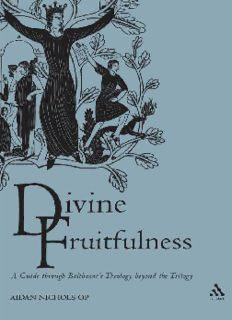
Divine Fruitfulness: A Guide to Balthasar's Theology beyond the Trilogy PDF
Preview Divine Fruitfulness: A Guide to Balthasar's Theology beyond the Trilogy
Divine Fruitfulness Previous volumes in the Introduction to Hans Urs Von Balthasar series The Word Has Been Abroad: A Guide Through Balthasar’s Aesthetics No Bloodless Myth: A Guide Through Balthasar’s Dramatics Say It Is Pentecost: A Guide Through Balthasar’s Logic ScatteringtheSeed:AGuideThroughBalthasar’sEarlyWritingsonPhilosophyand the Arts Divine Fruitfulness A Guide through Balthasar’s Theology beyond the Trilogy Aidan Nichols, OP PublishedbyT&TClark AContinuumimprint TheTowerBuilding,11YorkRoad,LondonSE17NX 80MaidenLane,Suite704,NewYork,NY10038 www.continuumbooks.com Allrightsreserved.Nopartofthispublicationmaybereproducedortransmittedin anyformorbyanymeans,electronicormechanical,includingphotocopying, recordingoranyinformationstorageorretrievalsystem,withoutpermissionin writingfromthepublishers. Copyright#AidanNichols,2007 AidanNicholshasassertedhisrightundertheCopyright,DesignsandPatentsAct, 1988,tobeidentifiedasAuthorofthiswork. ISBN-100567089339(hardback) 0567089347(paperback) ISBN-139780567089335(hardback) 9780567089342(paperback) BritishLibraryCataloguing-in-PublicationData AcataloguerecordforthisbookisavailablefromtheBritishLibrary TypesetbyYHTLtd,London Printedonacid-freepaperinGreatBritainby MPGBooksLtd,Bodmin,Cornwall Contents Preface vii 1. INTRODUCTIONTOTHEWIDEROEUVRE 1 PARTONE:SOURCES 2. DIVINEPREDECESSORS:THEFATHERSOFTHECHURCH 23 3. DIVINEMENTOR:HENRIDELUBAC 57 4. DIVINE INTERLOCUTOR:KARLBARTH 75 5. DIVINEHELPMATE:ADRIENNEVONSPEYR 109 PARTTWO:THEMES 6. DIVINECONCEIVING:REVELATIONANDTHEOLOGY 127 7. DIVINEPROVIDING:TIMEANDHISTORY 143 8. DIVINECLIMAX:THEPASCHALMYSTERY 165 9. DIVINESOCIETY:THECHURCH 195 10. DIVINEHANDMAID:THEMOTHEROFTHELORD 229 11. DIVINEMISSIONS:THESAINTS 237 12. DIVINELIVING:PRAYERANDMYSTICISM 259 13. DIVINETELLING:ONCHRISTIAN LITERATURE 289 CONCLUSION:FRUITFULREFLECTION 337 BIBLIOGRAPHICALNOTE 345 INDEXOFNAMES 347 INDEXOFSUBJECTS 351 v This page intentionally left blank Preface With the present work I conclude the five-volume Introduction to Hans Urs von Balthasar which has offered readers a series of ’guides’ to the different parts of his corpus. In calling this fifth and final instalment a ’Guide to Balthasar’s Theology’, I mean to institute a contrast with the fourth book in the series, Scattering the Seed, which took as subject his early writings on philosophyandthearts.InBalthasar’smaturetheologyweseetheseedthere sown springing up, flowering and fruiting in an abundance of theological applications. Hence the title of the book to which this is the Preface: Divine Fruitfulness.Itssubtitlealsoincludesthewords,’BeyondtheTrilogy’.Tomy threestudiesdedicatedtoBalthasar’sgreatTrilogy(TheWordhasbeenAbroad on histheological aesthetics, NoBloodless Mython histheological dramatics, Say itis Pentecoston histheological logic), DivineFruitfulnessgoes further in four respects. First, while at the opening of my three-part commentary on the Trilogy I offeredanintroductiontoBalthasar’slife-storyaswellastotheworksofthe Trilogyitself,hereintheopeningchapter,’IntroductiontotheWiderOeuvre’, Iventuretoconsidernotonlyotheraspectsofhisliteraryproductionbutalso the Church-political context of his work. How did he see contemporary Catholicism–and,forthatmatter,howdiditseehim?Secondly,whereasmy studies of the Trilogy touch wherever appropriate on the literally dozens of writers – both Christian and non-Christians – of whom Balthasar makes occasional use, this book identifies the principal origins of his architectonic approach tothestructure, contentandethos of theology as awhole.(Hence the overall title given to Chapters 2 to 5: ’Sources’.) Thirdly, though the Trilogy contains, no doubt, Balthasar’s richest theological fare, to grasp the bread-and-butter of his theological doctrine the remaining writings are fre- quently more helpful. To alter the metaphor from gastronomy to optics: the aesthetics, dramatics and logic offer three perspectives on revelation, per- spectives that correspond to the three ’transcendentals’, the beautiful, the good,thetrue.Butthatisnottosaythatthegreataffirmationsofrevelation, and the major motifs of the Christian life, are incapable of exhibition by a multi-focalapproachwhichprescindsfromtheseparticular’formalities’–to use the more precise Scholastic expression in place of the somewhat impressionistic contemporary term ’perspective’. (Hence the overall title given to Chapters 6 to 13: ’Themes’.) Fourthly, while Say it is Pentecost included a brief ’Postword’, Divine Fruitfulness offers a Conclusion to the vii viii Preface whole five-part series, asking at greater length the question, What will the Catholic theology of the twenty-first century (and later) owe to this enor- mously ambitious oeuvre? There are several notable introductions to Balthasar’s thought by other writers, and these of course necessarily overlap to varying degrees with the matter I present in this book as in the others in the series. However, it is a feature of Divine Fruitfulness that I make use of a good deal of rather inac- cessibleBalthasarmaterial,publishedforthemostpartinSwissnewspapers and magazines, much of which, I think I am right in saying, has not been drawnuponbefore.MythanksgotoDonWillyVolonte´,DeanoftheFaculty ofTheologyofLugano,duringmytwovisitsthere,formakingitpossiblefor me to consult the holdings of the Balthasar study centre housed in that institution,aswellastoFrauCorneliaCapolforsendingmephotocopiesof other items in the Archiv Hans Urs von Balthasar in Basle. Aidan Nichols, OP, Blackfriars, Cambridge, Solemnity of St George, Protector of the Realm, 2006 1 Introduction to the wider oeuvre Personal beginnings He began as a Germanist, a specialist in literature in the German language.1 He himself wrote an elaborate and highly polished German, which some critics,though,consideredinitselegancemorelikeFrenchandcertainlynot typical of the Swiss. It was, however, among the Swiss that he was born in Lucerne,on12August1905,intoapatricianfamilywhosehistorywentback centuries in this historically most Catholic of the Swiss cities and cantons – though on his mother’s side there was also Hungarian blood, from the landowning class in the Austro-Hungarian monarchy still flourishing, or relativelyso,atthetimeofhisbirth.HewenttoschoolwiththeBenedictines, in the glorious sub-alpine and Baroque setting of their abbey school at Engelberg,andlessmemorablywiththeJesuitsatFeldkirch intheAustrian Voralberg, before studying German literature and philosophy in the Uni- versities of Vienna, Berlin and Zurich. Towards the end of his doctoral studies at the University of Zurich his academic investigations of how the German poets and prosists saw ‘escha- tology’ – the ultimates in human existence – were punctuated by a new development in his personal life. While making the Spiritual Exercises of St Ignatius,hesuddenly‘knew’–hedescribesitalmostinrevelatoryterms–he shouldbeapriest.2HissubsequententryintotheSocietyofJesusin1929set himoffonhistheological–asdistinctfromliterary-philosophical–journey. While he did not enjoy the Neo-Scholastic teaching he received from the Jesuit study-house in Bavaria, he appreciated enormously the years of his formation spent with French members of the Society at Lyons, from 1933 to 1937.ThiswasatatimewhenCatholictheologyinFrancewasundergoinga littlerenaissancefoundedonreturntotheFathersandalisteningtoawider range of the voices of experience, notably from imaginative writers such as 1 IofferherewhatistosomeextentacomplementaryreadingofBalthasar’slifeandwork fromthatgiveninthefirstvolumeofmycommentaryontheTrilogy,TheWordHasBeen Abroad.AGuidethroughBalthasar’sAesthetics (Edinburgh,1998),pp.ix–xx.Thediffer- encelieschiefly(anexplanationofhisworkaspublisheraside)onhowBalthasarsaw boththeChurchofhisdayandhisownliteraryproduction,and,reciprocally,theway hisworkwasviewedbyotherpertinentpartiesintheCatholicChurch.Allworkscited arebyBalthasarunlessotherwiseindicated. 2 ‘Porque´ mehiceSacerdote’,inJ.–R.M.SansVila(ed.),Porque´mehiceSacerdote(Sala- manca,1959),pp.29–32,andhereatp.31. 1
Description: